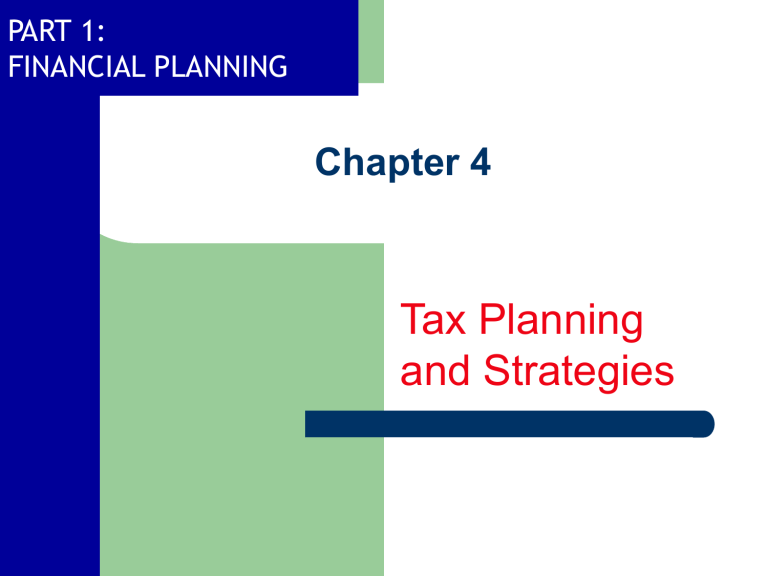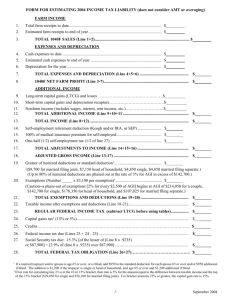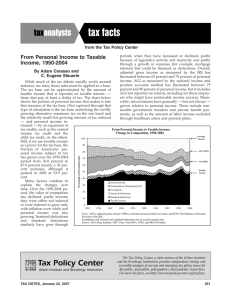Chapter 4 PPP

PART 1:
FINANCIAL PLANNING
Chapter 4
Tax Planning and Strategies
Learning Objectives
Explain how the present U.S. income tax system came into being.
Identify and understand the major tax features that affect all taxpayers.
Describe the other non-income-based taxes that you must pay.
Understand what is taxable income and how taxes are determined.
Choose the tax form that’s right for you.
Calculate your income taxes.
4-2
Taxes Then, Taxes Now
Tax Freedom Day – when the average
American has earned enough to pay federal, state, and local taxes for that year.
–
–
In 1950 Tax Freedom Day was March 31 st
In 2000 Tax Freedom Day was May 3 rd
– In 2005 Tax Freedom Day was April 17 th
Taxes are the single largest annual expenditure for most families.
4-3
The Federal Income
Tax Structure
Present tax structure is progressive or graduated, meaning increased income is taxed at increasing rates.
Tax brackets differentiate income levels.
This system is based on the idea that those who earn more can afford to pay a higher percentage of their income in taxes.
4-4
The Federal Income
Tax Structure
Not all income is taxed.
– Some income is tax-free because of personal exemptions.
– Some income is shielded by itemized or standard deductions.
Taxable income is a function of adjusted gross income (AGI), deductions, and exemptions.
4-5
The Federal Income
Tax Structure
Assume you are in the 15% tax bracket.
Does that mean you pay 15% of your taxable income in taxes?
No. Taxes are graduated, so income is taxed at increasing rates. The last dollar earned is taxed at 15%. Earlier income was taxed at the lower rate.
4-6
Marginal Versus Average Taxes
Average Tax Rate
Relates taxes to taxable or overall income. This is the average amount of your total income taken away in taxes.
Marginal Tax Rate
Looks at the percent of the last dollar earned that goes to pay taxes. This is also known as the marginal tax bracket.
4-7
Marginal Versus Average Taxes
Marginal tax rate is important when investing in a tax-deferred retirement plan.
Since the government allows tax deductions for contributions to retirement plans, a $1000 contribution, if you are in the 15% tax bracket, lowers your taxes by $150.
The reduction allows you to invest the entire
$1000 rather than only $850 ($1000 2 $150 in taxes).
4-8
Effective Marginal Tax Rate
Federal income taxes are not the only income-based taxes you pay. You pay:
–
–
–
State income taxes
City or local taxes
Social security taxes
As a result of these taxes, your effective marginal tax rate – the rate you pay when all income taxes are combined – is greater than the marginal tax rate on federal income taxes.
4-9
Capital Gains and
Dividend Income
A “capital gain” occurs when a capital asset is sold for a profit.
–
The tax paid on the gain is a “capital gains tax.”
– Assets held for 12 months or more qualify as a long-term capital gain, taxed at a lower rate.
A “capital loss” occurs when a capital asset is sold for a loss.
– Capital losses can offset capital gains.
4-10
Capital Gains and
Dividend Income
The tax laws provide a lower tax rate on both the long-term capital gains and on dividends.
Long-term capital gains tax applies to profits from the sale of stocks and bonds, it does not apply to collectibles.
You don’t pay the capital gains tax until the asset is sold.
4-11
Long-Term Capital
Gains on Homes
The Taxpayer Relief Act of 1997 effectively eliminates capital gains taxes on a house sale for most homeowners.
It exempts gains up to $500,000 for couples filing jointly.
–
–
Home must be the principal residence.
Must have been occupied for 2 of the past 5 years.
4-12
Filing Status
–
Single Married Filing Separately
Have no dependent children.
– Used if couples are separated or getting divorced.
Married Filing Jointly and
Surviving Spouses
– Combine income and deductions into a single return.
–
Head of Household
Unmarried and living with at least one child or relative.
4-13
Cost of Living Increases in Tax
Brackets, Exemptions, and Deductions
Since 1985, tax brackets have changed annually to reflect changes in the cost of living (inflation).
Standard deductions and personal exemptions are increased to reflect inflation.
This ensures that tax payments don’t increase just because of a cost of living increase in wages.
The increase caused by inflation is called “bracket creep.”
4-14
Paying Your Income Taxes
Most taxes are collected on a pay-as-you-go basis. Nearly all individual income taxes are collected through withholding from wages.
– These withholdings include social security, state, and local taxes.
– Taxes are also collected through quarterly estimated taxes sent to the IRS, payments with tax return, and withholdings from stock dividends, retirement funds, and prize winnings.
4-15
Paying Your Income Taxes
You have some control over how much is deducted for taxes from your wages.
– Withholdings are determined by income level and information on W-4 form.
4-16
Other Taxes
–
–
Income-Based Taxes
Social Security or FICA
State and local income taxes
Non-Income-Based Taxes
– Excise taxes – “sin taxes”
–
–
Property taxes
Gift and estate taxes
4-17
Calculating Your Taxes
If your income is more than $17,800 you must file a tax return.
Figure 4.1 lists the rules for who must file a return.
–
–
Dependents with income over $4850 from a job must file a return.
Those with unearned income, from investments, of $800 must file a return.
4-18
Calculating Your Taxes
Step 1: Determining Gross or Total Income
Total or gross income is the sum of all taxable income from all sources.
–
–
–
Active income – from wages, salaries or tips
Portfolio or investment income – securities
Passive income – activities in which the taxpayer does not actively participate
4-19
Calculating Your Taxes
Step 2: Calculating Adjusted Gross Income (AGI)
Adjusted gross income (AGI) is gross income less allowable deductions.
Adjustments include:
–
–
–
Payments set aside for retirement
Some moving expenses
Alimony payments
4-20
Calculating Your Taxes
Step 3: Subtracting Deductions
Choose between standard deduction or itemizing.
Standard deduction is the government’s best estimate of what the average person would deduct if itemizing.
4-21
Calculating Your Taxes
Step 3: Subtracting Deductions
Itemize deductions by listing all those allowable:
–
–
–
–
–
–
Medical and dental expenses
Tax expenses
Home mortgage and investment interest payments
Gifts to charity
Casualty and theft loss
Miscellaneous deductions
4-22
Calculating Your Taxes
Step 4: Claiming Your Exemptions
An exemption is a deduction for each person supported by the income on a tax return.
In 2004, each exemption lowered taxable income by
$3100.
Exemptions can be personal or dependency.
Once your AGI reaches a certain level, the value of the exemption is reduced.
4-23
Calculating Your Taxes
Step 5: Calculating Your Taxable Income, and From That,
Calculating Your Base Income
Taxable income = AGI 2 (deductions and exemptions).
Once taxable income is determined, the income tax can be found in the federal income tax booklet.
– Taxable income above $100,000 determined by rate schedules.
Alternative minimum tax (ATM) ensures that everyone pays taxes.
4-24
Calculating Your Taxes
Step 6: Subtract Your Credits and
Determine Your Taxes Due
Tax credits offset taxes in a direct manner – not merely reducing taxable income but offsetting taxes.
–
–
–
Child Credit
The Hope Scholarship Tax Credit and the Lifetime Learning Credit
Other Tax Credits
Child and dependent care credit
Earned income credit
Adoption credit
4-25
Other Filing Considerations
Choosing a tax form
–
–
1040EZ – no dependents, income under
$100,000, no itemizing.
1040A – the original easy form, $100,000 total taxable income, allows dependents, and IRA contributions.
4-26
Other Filing Considerations
Choosing a tax form
– 1040 – the “long form,” allows for itemized deductions and adjustments to income.
A schedule is an attachment to this form providing information on income and expenses listed on 1040.
4-27
Other Filing Considerations
Electronic Filing
Over half of all taxpayers file electronically
Benefits include:
– Faster refunds
–
–
More accurate returns
Quick electronic confirmation
– Easy payment options
4-28
Filing Late and Amended Returns
File Late – Form 4868 - request an extension if unable to file by April 15 th and include estimated tax payment.
– If no enclosed check, then charged interest on taxes.
Amended Return - Form 1040X – file within
3 years of original tax date.
– Amend the state and local forms as well.
4-29
Being Audited
IRS audits over 1 million taxpayers annually.
Why an audit?
–
–
Randomly selected
Audited in the past
–
–
–
High income
Itemized deductions
Self-employment income
Keep good records and appeal audit outcome if necessary.
4-30
Help in Preparing Taxes
Handle taxes by yourself.
– Use IRS booklets, toll-free hot line, or walk in service.
Use self-help publications and computer programs.
Hire a tax specialist
– National affiliations
– Independent tax specialists
4-31





